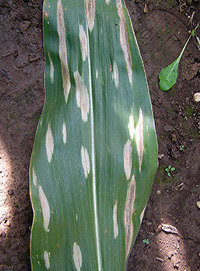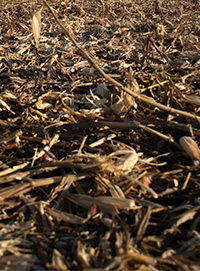Choosing to go with a corn-after-corn rotation isn't a move entered into lightly given the potential yield hit you might take. Yet by implementing a few tactics you can turn the odds in your favor for maximizing results. The 2021 season is filled with weather challenges, but even in that environment there are key moves you can make to maximize returns.
With corn prices on the rise, corn-following-corn may have been a more popular "rotation" this year given the potential for that crop despite some of the possible impediments to performance. There are many reasons farmers choose this approach, from a need to feed beef or hogs, to benefitting from manure for that crop, to taking advantage of a better price when selling to a local ethanol plant.
And continuous corn can help bring more organic matter back into the soil given the high levels of residue available.
To make the most of the rotation, there are some tactics to consider.
1. Check corn-on-corn fields for nitrogen and sulfur deficiency
"Continuous corn needs more nitrogen," says Fred Below, Extension plant physiologist, University of Illinois. "We used to think we got a nitrogen credit from soybeans as the crop before corn, but in reality there is no soybean N credit but rather a corn residue penalty."
Below advises scouting fields and considering an in-season application of nitrogen to keep that crop going. "Side-dress more nitrogen, and add sulfur into the mix too," he says. "Do that side-dress as a Y-drop if you can, since that places the nutrients in close proximity to the crop's roots and improves uptake efficiency."
Dan Quinn, extension agronomist, Purdue University, advises not using a granular product for side-dressing those acres. "The residue could keep it from getting to the crop," he notes.
Mark Licht, extension cropping specialist, Iowa State University, observes that continuous corn often takes a hit when environmental conditions stress the crop. In Iowa, for example, dry conditions are causing trouble.
"We're starting off this year a little rougher, and my guess is this will be harder on continuous corn. The drier conditions mean we're not going to mineralize the available nitrogen," he adds. "And that residue won't be decomposing quite as rapidly."
"We're starting off this year a little rougher, and my guess is this will be harder on continuous corn. The drier conditions mean we're not going to mineralize the available nitrogen."
Matt Essick, Pioneer agronomy manager, notes that dialing in the right amount of nitrogen, and its timing, on the corn crop can be a challenge. "That seems to be one of the biggest limiting factors when it comes to managing corn, so that's one of the things I'd be thinking about now."
2. Scout for diseases that target your region
The residues farmers deal with in a continuous corn system can also be a nice home to spores for key corn diseases. Depending on your area, that may include gray leaf spot or Northern corn leaf blight. Scouting for both is valuable mid-season since there are a wide range of effective fungicides available to protect that crop.
It's also a time to evaluate your seed purchase. "Hopefully we did a really good job of planning and selecting the right hybrids for the fields," says Essick. "It's a good time to evaluate what's going on this year to set ourselves up for success next season."
Licht notes that plant breeders have helped take on one challenge. "You know it was nearly 10 years ago we were talking about Goss's Wilt, and you don't hear much about that anymore," he says. "Plant breeders brought resistance."
Scouting for disease early can guide your response for fungicide use, and for dealing with other issues including insect pressure.
3. Consider action at harvest
Talk to anyone about continuous corn these days and "residues" are the hot topic. The rising yield of your average acre of corn leaves behind a pretty good pile of biomass to deal with and planning for that challenge is important. It's often been said that the next season begins off the back of the combine, and nowhere is that more true than with corn-following-corn.
Below has been working with one equipment maker that uses an approach that sizes residues during harvest. "You can knock 10 bushels off the yield penalty if you size that residue at harvest," he says.
Whether you use a chopping combine head at harvest or tune your combine to spread that chaff in a wider, more even pattern, consider how you manage residues. Licht notes that application of liquid N has not been shown to enhance the rate of corn residue breakdown.
"You can knock 10 bushels off the yield penalty if you size that residue at harvest."
He adds that decomposing corn residues "do immobilize nitrogen. That's one of the reasons why there's a different nitrogen need in continuous corn versus a corn-following-soybean rotation."
Pioneer's Essick also advises a little harvest timing. "If I have fields that are going to be corn-following-corn, I do like to harvest those as soon as I can in my harvest cycle," he says. "If you're all corn-on-corn that makes that challenging, but if it's only on certain acres, the sooner you get those harvested the faster the residue breakdown process can begin."
4. Plan for planting
Rising interest in reduced, or no-till, can make sense for an operation, but in a corn-on-corn rotation heavy residues need to be taken into consideration. "There are arguments about how much tillage we should be doing," Licht says. "I've seen continuous corn that utilizes strip tillage very effectively, so I think that's a viable system."
If you’ve dealt with corn residue off the combine, assessing your planting needs over the winter can pay off. Another important step is evaluating your hybrid choices for 2022.
Purdue's Quinn notes that corn-on-corn can create a stressful environment for hybrids. "Besides selecting for disease tolerance because you have that risk for extra potential for disease in continuous corn, choose hybrids that are more tolerant to stress," he says. " Seed companies often evaluate and designate hybrids by their tolerances to stress, and selecting those that show higher stress tolerance would be good."
Quinn adds that scouting is an important tool for following-year hybrid selection. "Understanding the pests that are out there and what traits you need is important," he notes.
Corn rootworm is a major challenge for continuous corn. Selecting traited hybrids that target the problem makes sense. ISU's Licht notes that if you appear to be dealing with resistance you have some options. "You can move to a non-GMO corn and apply insecticide to help break the cycle," he notes. "Or you can rotate to a non-host crop."
5. Maximize the payoff
The challenge of corn-on-corn sometimes appears to overcome the benefits; yet the choice can be profitable with more focused management. The aim is to reduce any yield hit you may face.
"Corn rootworm is a major challenge for continuous corn. Selecting traited hybrids that target the problem makes sense."
Corn is a crop that responds well to inputs. "Corn clearly responds to management better than soybeans," says Below from Illinois. "You need to think about the tools you have."
Investing in harvest management, hybrid selection, nutrient timing and scouting can help overcome any yield penalty for corn-following-corn. In a year when $6 corn is a reality, that can be a significant profit booster.
This content produced by Farm Progress for Corteva Agriscience.



